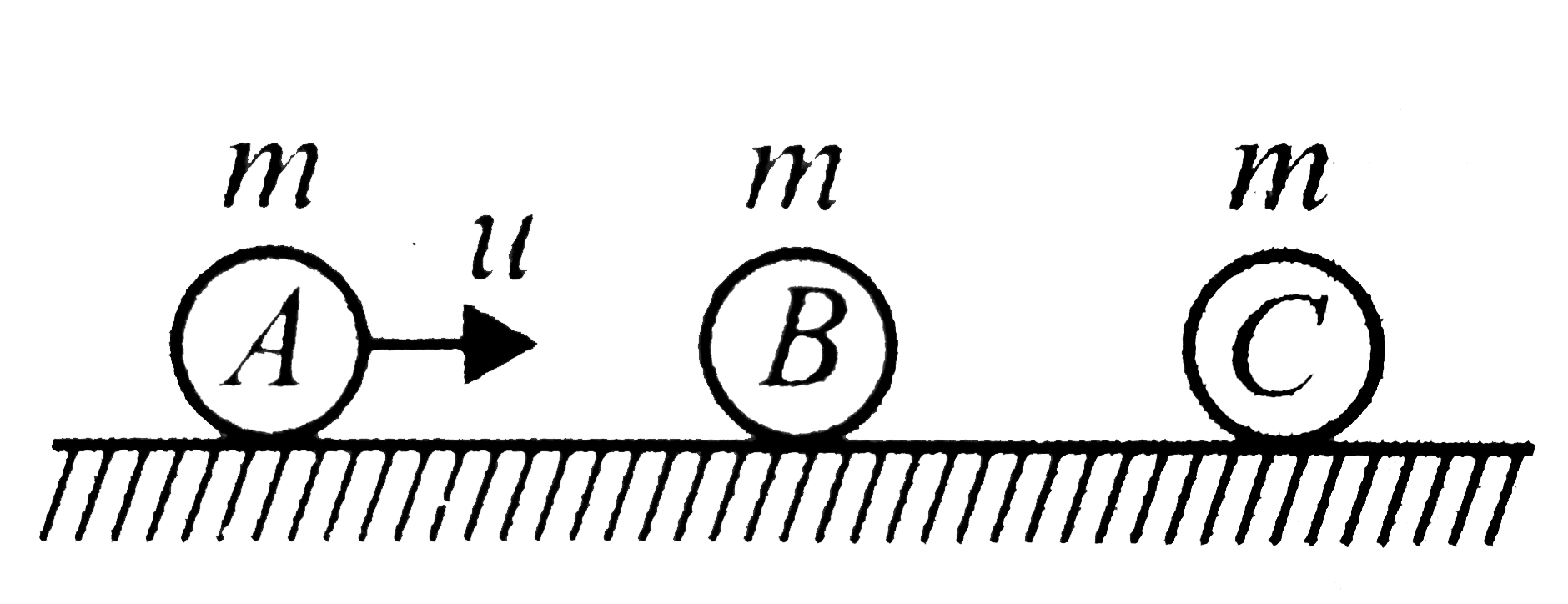Three block A,Band C whose masses are m,km and 4m respectively kept at rest on the horizontal smooth surface, as shown in the figure. The ball A is given velocity v0, rightward and it collides with the ball B elastically. Then ball B callides elastically third ball C. For what value of k, does the third ball C receive the maximum speed ?

The correct Answer is:2
Step by step video, text & image solution for Three block A,Band C whose masses are m,km and 4m respectively kept at rest on the horizontal smooth surface, as shown in the figure. The ball A is given velocity v_(0), rightward and it collides with the ball B elastically. Then ball B callides elastically third ball C. For what value of k, does the third ball C receive the maximum speed ? by Physics experts to help you in doubts & scoring excellent marks in Class 12 exams.
Updated on:21/07/2023Topper's Solved these Questions
- KINEMATICSBOOK - FIITJEECHAPTER - KINEMATICSEXERCISE - SECTION(II) : MCQ ( SINGLE CORRECT)
47 Videos
- KINEMATICSBOOK - FIITJEECHAPTER - KINEMATICSEXERCISE - MCQ (MULTIPLE CORRECT)
15 Videos
- KINEMATICSBOOK - FIITJEECHAPTER - KINEMATICSEXERCISE - SECTION(I): MCQ (SINGLE CORRECT)
120 Videos
- HEAT AND TEMPERATUREBOOK - FIITJEECHAPTER - HEAT AND TEMPERATUREEXERCISE - NUMERICAL BASES QUESTIONS
1 Videos
- LAWS OF MOTIONBOOK - FIITJEECHAPTER - LAWS OF MOTIONEXERCISE - COMPREHENSION-III
2 Videos
Similar Questions
Three identical balls 1, 2 and 3 are placed together at rest on a smooth horizontal surface. A fourth identical ball moving with velocity u in line of first three balls collides head on elastically as shown in figure, then

View SolutionThree balls A,B and C of same mass m are placed on a frictionless horizontal plane in a straight line as shown. Ball A is moved with velocity u towards the middle ball B. If all the collisions are elastic, find the final velocities of all the balls.

View Solution
Knowledge Check
Three blocks A, B and C each of mass m are placed on a surface as shown in the figure. Blocks B and C are initialyy at rest. Block A is moving to the right with speed v. It collides with block B and stricks to it. The A-B combination collides elastically with block C. Which of the following statement is (are) true about the velocity, of block B and C.
 AVelocity of the block C after collision is 2/3v towards rightBVelocity of the A−B combination after collision is v3 towards leftCVelocity of the A−B combination after collision is 23v towards leftDVelocity of the block C after collision is v3 towards right.
AVelocity of the block C after collision is 2/3v towards rightBVelocity of the A−B combination after collision is v3 towards leftCVelocity of the A−B combination after collision is 23v towards leftDVelocity of the block C after collision is v3 towards right.Two balls marked 1 and 2 of the same mass m and a third ball marked 3 of mass M are arranged over a smooth horizontal surface as shown in the figure. Ball 1 moves with a velocity v1 towards ball 2. All collisions are assumed to be elastic. If M<m, the number of collisions between the balls will be.
 A1B2C3D4
A1B2C3D4Two balls each of mass 'm' are moving with same velocity v on a smooth surface as shown in figure. If all collisions between the balls and balls with the wall are perfectly elastic, the possible number of collisions between the balls and wall together is
 A1B2C3DInfinity
A1B2C3DInfinity
Masses of the bodies A,B and C are 1 kg, 2 kg and 3 kg respectively. There is no friction between the ground and the bodies. Initially ball A is moving with a avelocity 20 m/s collieds inelhastically (e=0.5) with the ball B,which was initially at rest. The ball B further colides elasticaly to the block C (at rest), and then C collides elastically to the will in front. Find the velocities of the three blocks after all collisions occurred.

View SolutionTwo balls each of mass 'm' are moving with same velocity v on a smooth surface as shown in figure. If all collisions between the balls and balls with the wall are perfectly elastic, the possible number of collisions between the balls and wall together is

View SolutionTwo balls A & B of mass m1 and m2 are kept on a horizontal smooth surface. A is given a velocity towards B so that they perform head on collision
View SolutionFour smooth steel balls of equal mass at rest are free to move along a straight line without friction. The first ball is given a velocity of 0.4 m/s . It collides head on with the second elastically, the second one similarly with the third and so on. The velocity of the last ball is
View SolutionFour smooth steel balls of equal mass at rest are free to move along as straight line without friction. The first ball is given a velocity of 0.4m/s It colloids head on with the second elastically, the second one similarly with the third and so on. the velocity of the last ball is :
View Solution
